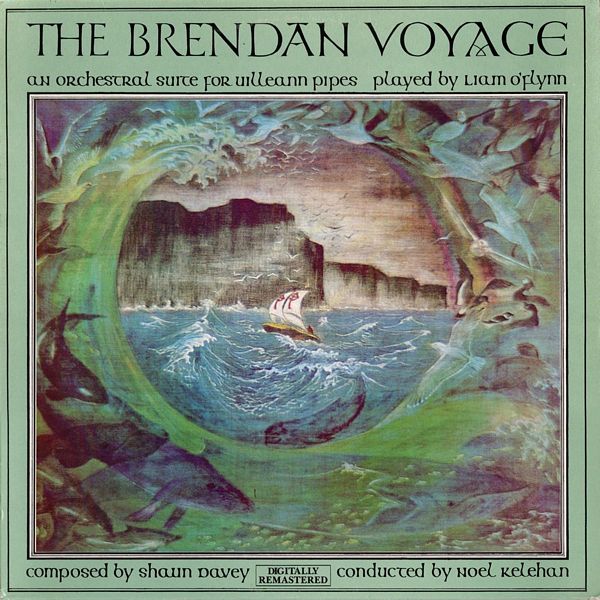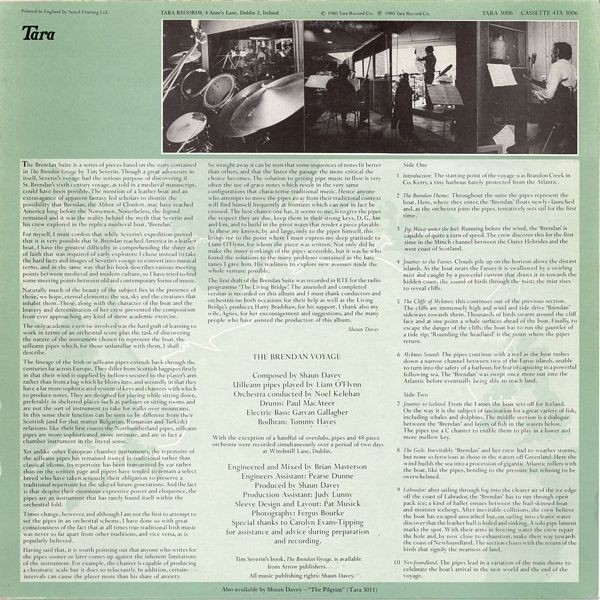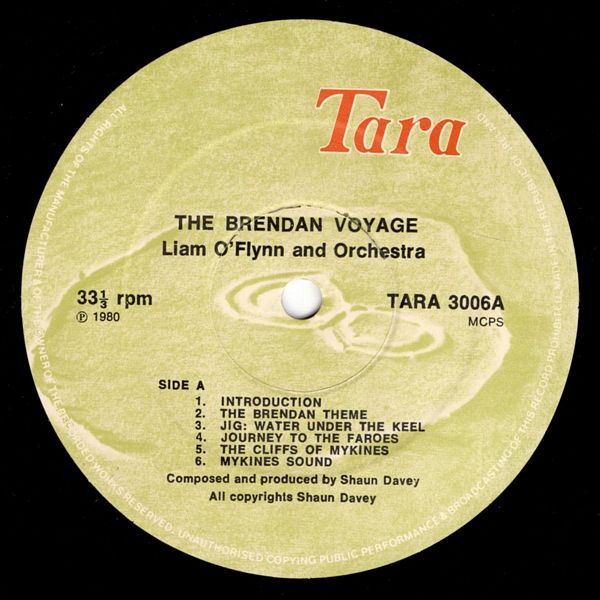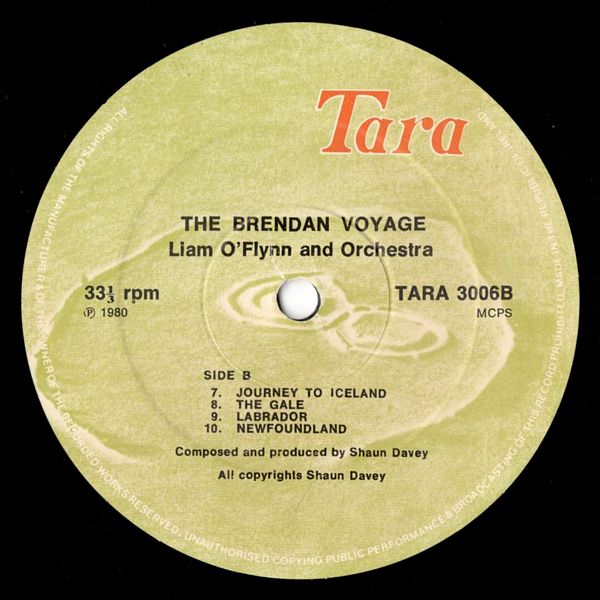
 |


 |
Sleeve Notes
The Brendan Suite is a series of pieces based on the story contained in The Brendan Voyage by Tim Severin. Though a great adventure in itself, Severin's voyage had the serious purpose of discovering if St. Brendan's sixth century voyage, as told in a medieval manuscript, could have been possible. The mention of a leather boat and an extravagance of apparent fantasy led scholars to dismiss the possibility that Brendan, the Abbot of Clonfert, may have reached America long before the Norsemen. Nonetheless, the legend remained and it was the reality behind the myth that Severin and his crew explored in the replica medieval boat, 'Brendan!
For myself, I must confess that while Severin's expedition proved that it is very possible that St. Brendan reached America in a leather boat, I have the greatest difficulty in comprehending the sheer act of faith that was required of early explorers: I chose instead to take the hard facts and images of Severin's voyage to convert into musical terms, and in the same way that his book describes various meeting points between medieval and modern culture, so I have tried to find some meeting points between old and contemporary forms of music.
Naturally much of the beauty of the subject lies in the presence of those, we hope, eternal elements; the sea, sky and the creatures that inhabit them. These, along with the character of the boat and the bravery and determination of her crew prevented the composition from ever approaching any kind of mere academic exercise.
The only academic exercise involved was the hard graft of learning to work in terms of an orchestral score plus the task of discovering the nature of the instrument chosen to represent the boat, the uilleann pipes which, for those unfamiliar with them, I shall describe.
The lineage of the Irish or uilleann pipes extends back through the centuries far across Europe. They differ from Scottish bagpipes firstly in that their wind is supplied by bellows secured to the player's arm rather than from a bag which he blows into, and secondly in that they have a far more Sophisticated system of keys and chanters with which to produce notes. They are designed for playing while sitting down, preferably in sheltered places such as parlours or sitting rooms and are not the sort of instrument to take for walks over mountains.
In this sense their function can be seen to be different from their Scottish (and for that matter Bulgarian, Rumanian and Turkish) relations: like their first cousin the Northumberland pipes, uilleann pipes are more sophisticated, more intimate, and are in fact a chamber instrument in the literal sense.
Yet unlike other European chamber instruments, the repertoire of the uilleann pipes has remained rooted in traditional rather than classical idioms. Its repertoire has been transmitted by ear rather than on the written page and pipers have tended to remain a select breed who have taken seriously their obligation to preserve a traditional repertoire for the sake of future generations. And the fact is that despite their enormous expressive power and eloquence, the pipes are an instrument that has rarely found itself within the orchestral fold.
Times change, however, and although I am not the first to attempt to set the pipes in an orchestral scheme, I have done so with great consciousness of the fact that at all times true traditional Irish music was never so far apart from other traditions, and vice versa, as is popularly believed.
Having said that, it is worth pointing out that anyone who writes for the pipes sooner or later comes up against the inherent limitations of the instrument. For example, the chanter is capable of producing a chromatic scale but it does so reluctantly. In addition, certain intervals can cause the player more than his share of anxiety.
So straight away it can be seen that some sequences of notes fit better than others, and that the faster the passage the more critical the choice becomes. The solution to getting pipe music to flow is very often the use of grace notes which result in the very same configurations that characterise traditional music. Hence anyone who attempts to move the pipes away from their traditional context will find himself frequently at frontiers which can not in fact be crossed. The best chance one has, it seems to me, is to give the pipes the respect they are due, keep them in their strong keys, D, G, Am and Em, and to build in the pivot notes that render a piece playable. As these are known, by and large, only to the piper himself, this brings me to the point where I must express my deep gratitude to Liam O'Flynn, for whom the piece was written. Not only did he make the inner workings of the pipes accessible, but it was he who found the solutions to the many problems contained in the bare tunes I gave him. His readiness to explore new avenues made the whole venture possible.
The first draft of the Brendan Suite was recorded in RTE for the radio programme 'The Living Bridge'. The amended and completed version is recorded on this album and I must thank conductors and orchestras on both occasions for their help as well as the Living Bridge's producer, Harry Bradshaw, for his support. I thank also my wife, Agnes, for her encouragement and suggestions, and the many people who have assisted the production of this album.
Shaun Davey
Introduction: The starting point of the voyage was Brandon Creek in Co. Kerry, a tiny harbour barely protected from the Atlantic.
The Brendan Theme: Throughout the suite the pipes represent the boat. Here, where they enter, the 'Brendan' floats newly-launched and, as the orchestra joins the pipes, tentatively sets sail for the first time.
Jig; Water under the keel: Running before the wind, the 'Brendan' is capable of quite a turn of speed. The crew discover this for the first time in the Minch channel between the Outer Hebrides and the west coast of Scotland.
Journey to the Faroes: Clouds pile up on the horizon above the distant islands. As the boat nears the Faroes it is swallowed by a swirling mist and caught by a powerful current that draws it in towards the hidden coast; the sound of birds through the mist; the mist rises to reveal cliffs.
The Cliffs of Mykines: this continues out of the previous section. The cliffs are immensely high and wind and tide drive 'Brendan' sideways towards them. Thousands of birds swarm around the cliff face and at one point a whale surfaces ahead of the boat. Finally, to escape the danger of the cliffs, the boat has to run the gauntlet of a tide rip; 'Rounding the headland' is the point where the pipes return.
Mykines Sound: The pipes continue with a reel as the boat rushes down a narrow channel between two of the Faroe Islands, unable to turn into the safety of a harbour, for fear of capsizing in a powerful following sea. The 'Brendan' was swept once more out into the Atlantic before eventually being able to reach land.
Journey to Iceland: From the Faroes the boat sets off for Iceland. On the way it is the subject of fascination for a great variety of fish, including whales and dolphins.The middle section is a dialogue between the 'Brendan' and layers of fish in the waters below. The pipes use a C chanter to enable them to play in a lower and more mellow key.
The Gale: Inevitable 'Brendan' and her crew had to weather storms, but none so ferocious as those in the waters off Greenland. Here the wind builds the sea into a procession of gigantic Atlantic rollers with the boat, like the pipes, bending to the pressure but refusing to be overwhelmed.
Labrador: after sailing through fog into the clearer air of the ice edge off the coast of Labrador, the 'Brendan' has to run through open pack ice; a kind of ballet ensues between the frail-skinned boat and monster icebergs. After inevitable collisions, the crew believe the boat has escaped unscathed but, on sailing into clearer water discover that the leather hull is holed and sinking. A solo pipe lament marks the spot. With their arms in freezing water the crew repair the hole and, by now close to exhaustion, make their way towards the coast of Newfoundland. The section closes with the return of the birds that signify the nearness of land.
Newfoundland: The pipes lead in a variation of the main theme to celebrate the boat's arrival in the new world and the end of the voyage.